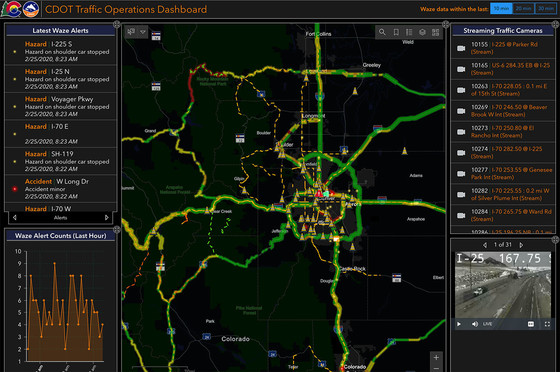Innovation of the Month:
Crowdsourcing for Operations
So far this month, we have discussed several State applications of crowdsourcing for operations that directly benefit motorists by providing real-time travel updates and warnings of potential hazards on the roadway. Crowdsourcing also helps agencies manage traffic operations more efficiently.
The Colorado Department of Transportation (CDOT) recently launched a new map-based traffic operations dashboard that pulls in real-time crowdsourced data from HERE™ and Waze™.
 The CDOT interactive traffic operations dashboard provides a graphical representation of Waze alerts, information on new alerts, frequency of alerts, and access to traffic cameras. This system has allowed a 5-10 minute reduction in response time to incidents. Credit: CDOT
CDOT’s traffic operations centers actively use this dashboard to quickly and efficiently respond to reports. When crashes, debris hazards, and delays are reported through the Waze™ app, they are populated into the dashboard. Once alerted, operators can verify the incident and dispatch the appropriate resources. Getting this information in real-time, as opposed to waiting for a call from law enforcement or the public, has allowed CDOT to be more proactive in its response to incidents, especially minor ones, which do not always result in a call. Faster detection and verification through the dashboard allows CDOT to deploy resources, such as the safety patrol or traffic control, quickly. Operators have reported a reduction in response times between 5 and 10 minutes, which can go a long way in preventing or reducing incident-related congestion and avoiding secondary crashes.
To learn more about how your agency can use crowdsourced data to improve traffic operations, please contact James Colyar or Paul Jodoin of the Federal Highway Administration Office of Operations.
UAS Soar to Savings with Sign Inspections
The Utah Department of Transportation (UDOT) uses Unmanned Aerial Systems extensively in programs across the State. UDOT has the majority of its bridge inspectors FAA certified to operate UAS and has several members of maintenance staff certified to conduct sign inspections, snow depth analysis, and asset inspections.
Before UAS, overhead sign inspections were a time consuming process. These inspections, which look for missing rivets and bolts after installation, could only cover two to three signs per day with traditional methods and required additional traffic control to protect department personnel. By contrast, in one project assessing signs on State Route 201 and I-80, UAS enabled UDOT inspectors to complete up to 16 inspections per day, saving over $100,000 through productivity increases and reduced needs for traffic control.
To learn more about how UAS can save your agency time and money, contact James Gray, FHWA Office of Infrastructure.
FHWA Awards $8 Million to 10 States for Innovative Highway Projects
FHWA recently announced more than $8 million in Accelerated Innovation Deployment (AID) Demonstration program grants to state departments of transportation (DOTs) and local governments in Alabama, Arkansas, Colorado, Florida, Illinois, Iowa, Michigan, Minnesota, New York, and North Dakota. The grants will help deliver bridge projects sooner, improve traffic management, and accelerate the use of innovative tools and technologies:
- The Alabama DOT and Baldwin County will employ accelerated bridge construction and next beam ultra high-performance concrete retrofitting to shorten construction time from 14 to 6 weeks on bridge retrofit projects.
- The Arkansas DOT will use 3D modeling and e-Construction to enhance use of global navigation satellite system technology in the engineering and construction phases of projects.
- The Colorado DOT will use snow plow signal priority to improve traffic flow during and after snow removal.
- The Florida DOT and City of Orlando will improve traffic signalization at intersections in Orlando and fund a pilot demonstration that is part of a larger project to intelligently manage transportation flows around downtown Orlando.
- The Illinois DOT and City of Jerseyville will use compacted concrete pavement to improve roadway surface conditions.
- The Iowa DOT and City of Dubuque will develop a smart, next-generation traffic management and control system to link 11 corridors into one integrated system.
- The Michigan DOT will use accelerated bridge construction and prefabricated bridge elements and systems (PBES) to reduce potential delays during project construction.
- The Minnesota DOT and City of Winona will improve safety, mobility, and access for drivers and bicyclists.
- The New York State DOT will improve traffic incident management on a region-wide basis.
- The North Dakota DOT will deploy an autonomous crash truck to protect workers from traffic during routine maintenance activities.
Since 2014, FHWA officials have awarded more than $74 million for 102 grants to help federal land management agencies, tribal governments, state DOTs, metropolitan planning organizations, and local governments accelerate the use of innovative practices and improve safety through AID Demonstration. To learn more about the 2019 AID Demonstration grants, read the full FHWA press release, and to learn more about the AID Demonstration program, please contact Fawn Thompson, AID Demonstration program coordinator.
|